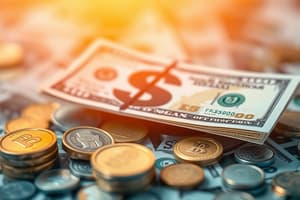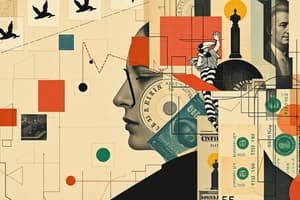Podcast
Questions and Answers
What is the primary goal of the course?
What is the primary goal of the course?
- To comprehend the functioning of exchange rates between currencies (correct)
- To learn about stock trading strategies
- To study historical financial crises
- To understand domestic financial regulations
Which of the following statements about the final examination is true?
Which of the following statements about the final examination is true?
- It includes both open questions and numerical exercises (correct)
- It consists of multiple-choice questions only
- It is an open-book exam
- It is based solely on textbook readings
How are lecture slides made available to students?
How are lecture slides made available to students?
- Posted on the university's website only
- Printed copies distributed in class
- Shared through email each week
- Uploaded weekly on Moodle (correct)
What is the scheduling pattern of the lectures?
What is the scheduling pattern of the lectures?
Which book is NOT listed as part of the recommended bibliography?
Which book is NOT listed as part of the recommended bibliography?
Which of the following is true regarding the office hours for the course?
Which of the following is true regarding the office hours for the course?
What type of examination will students NOT encounter in this course?
What type of examination will students NOT encounter in this course?
How will students be notified of variations in the course schedule?
How will students be notified of variations in the course schedule?
What is the main inconvenience of a barter economy?
What is the main inconvenience of a barter economy?
For money to function effectively, it must be stable in which aspect?
For money to function effectively, it must be stable in which aspect?
Which of the following was one of the first types of money used in ancient civilizations?
Which of the following was one of the first types of money used in ancient civilizations?
What was the primary reason for the monopolization of coin issuance by local authorities?
What was the primary reason for the monopolization of coin issuance by local authorities?
What led to the transition from metal coins to paper banknotes around 1200?
What led to the transition from metal coins to paper banknotes around 1200?
What is one significant change in the production of banknotes that occurred by 1850?
What is one significant change in the production of banknotes that occurred by 1850?
What is the current form of money in the electronic age?
What is the current form of money in the electronic age?
What characteristic of money ensures ease of transport and storage?
What characteristic of money ensures ease of transport and storage?
What does the term 'currency' originate from?
What does the term 'currency' originate from?
Which of the following currencies is denoted by the symbol ¥?
Which of the following currencies is denoted by the symbol ¥?
What is the origin of the name 'dollar'?
What is the origin of the name 'dollar'?
What is the key distinction between ask price and bid price in currency exchange?
What is the key distinction between ask price and bid price in currency exchange?
What does the GBP symbol stand for?
What does the GBP symbol stand for?
Which of the following reflects the connection of modern currencies to weight systems?
Which of the following reflects the connection of modern currencies to weight systems?
How can an exchange rate be expressed?
How can an exchange rate be expressed?
What is the primary confusion regarding exchange rates?
What is the primary confusion regarding exchange rates?
What is the defined purpose of a currency?
What is the defined purpose of a currency?
Which ISO code corresponds to the currency of Japan?
Which ISO code corresponds to the currency of Japan?
What distinguishes domestic currency from foreign currency?
What distinguishes domestic currency from foreign currency?
Which country uses the currency known as the Hryvnia?
Which country uses the currency known as the Hryvnia?
What is the currency of Canada?
What is the currency of Canada?
What ISO code represents the currency of Argentina?
What ISO code represents the currency of Argentina?
Which currency uses the symbol '€'?
Which currency uses the symbol '€'?
What type of organization established the ISO codes for currencies?
What type of organization established the ISO codes for currencies?
Which of these is NOT a currency listed in the content?
Which of these is NOT a currency listed in the content?
What is the currency of Norway?
What is the currency of Norway?
Flashcards
Exchange rate
Exchange rate
The value of one currency expressed in terms of another currency. It determines how much of one currency is needed to purchase a unit of another.
Currency risk
Currency risk
The risk that the value of a company's assets, liabilities, or revenues will be affected by changes in exchange rates.
Multinational company
Multinational company
A company that operates in multiple countries, with activities in different currencies.
Final examination
Final examination
Signup and view all the flashcards
Moodle
Moodle
Signup and view all the flashcards
Lecture
Lecture
Signup and view all the flashcards
International Financial Modelling
International Financial Modelling
Signup and view all the flashcards
What is a currency?
What is a currency?
Signup and view all the flashcards
Domestic currency
Domestic currency
Signup and view all the flashcards
Foreign currency
Foreign currency
Signup and view all the flashcards
What is an ISO code?
What is an ISO code?
Signup and view all the flashcards
What is a currency symbol?
What is a currency symbol?
Signup and view all the flashcards
Currency conversion
Currency conversion
Signup and view all the flashcards
Fixed exchange rate
Fixed exchange rate
Signup and view all the flashcards
What is money?
What is money?
Signup and view all the flashcards
What makes money stable?
What makes money stable?
Signup and view all the flashcards
How must money be practical?
How must money be practical?
Signup and view all the flashcards
How has money evolved through history?
How has money evolved through history?
Signup and view all the flashcards
When did metal coins first appear?
When did metal coins first appear?
Signup and view all the flashcards
What were the origins of paper money?
What were the origins of paper money?
Signup and view all the flashcards
How did the focus from coins shift to banknotes?
How did the focus from coins shift to banknotes?
Signup and view all the flashcards
How has money evolved in modern times?
How has money evolved in modern times?
Signup and view all the flashcards
ISO code
ISO code
Signup and view all the flashcards
Currency symbol
Currency symbol
Signup and view all the flashcards
Study Notes
Course Information
- Course Title: International Financial Modelling
- Lecturer: Cosimo Munari
- Department: Department of Economics, University of Verona
- Lecture Date: October 2, 2024 (Lecture 1)
Logistics
- Office Location: Room 5, Floor 3, Viale Margherita 87, Vicenza
- Email: [email protected]
- Office Hours: Contact via email to schedule
Course Schedule
- Tentative Schedule: Provided with specific dates and times for each lecture
- Variations: Any changes will be announced in advance
- Lecture 01: Wednesday, October 2nd, 11:00 AM - 1:30 PM
- Lecture 13: Wednesday, November 27th, 11:00 AM - 1:30 PM
- (Other lectures have specific days and times in the table)*
Lectures and Exam
- Lectures: Audio-recorded and available on Moodle with slides uploaded weekly.
- Final Exam: Closed-book exam covering open and numerical questions
- Exam Content: Based on class lectures, slides, and discussed exercises.
- No Intermediate Exam: There is no mid-term exam
Bibliography
- Textbook Recommendations: A list of relevant books for further study:
- Benk, J., DeMarzo, P.: Corporate Finance, Pearson, 2011.
- Jacque, L.L.: International Corporate Finance, Wiley, 2020.
- Madura, J., Fox, R.: International Financial Management, Cencage, 2023.
- Sercu, P.: International Finance, Princeton University Press, 2009.
- Smithson, C.W.: Managing Financial Risk, McGraw-Hill, 1998.
- Slides As Primary Source: The slides are sufficient for exam preparation
Course Goal
- Exchange Rates: Understanding how exchange rates function
- Currency Risk: Understanding how multinational companies are exposed to currency risk
- Currency Risk Management: Learning how to manage currency risk for multinational companies
Money
- Medium of Exchange: Money is anything used as a medium of exchange
- Stability: Money's value should be stable to be useful
- Transactions Volatility: The money supply shouldn't rise faster than the transaction volume
- Portability: Easy to carry and store.
Money History
- Ancient Money: Initially, commodities like salt or cattle were used.
- Precious Metals: Later, precious metals like gold, silver, and bronze became more common.
- Coinage: Coinage introduced in ancient Greece around 550 BC
- Paper Money: International trade later necessitated paper banknotes as receipts for deposits, becoming true money, and central banking took over production by approximately 1850
- Modern Money: Today money is primarily in electronic bank records.
Currencies
- Definition: A currency is a system of money in a country.
- Categories: Domestic and foreign currencies.
- Identification: Currencies are identified by ISO codes
- ISO Organization: International Organization for Standardization (ISO) is the body that created these codes.
- Examples: Table listing many countries, their currencies, and ISO codes
Special Currency Symbols
- Specific Symbols: EUR (€), USD ($), GBP (£), JPY (¥)
Currencies in History
- Latin "currere": Word originated from the Latin word meaning "to flow."
- Weight systems: Early currencies were connected to weight systems
- Minting Authorities: Coin authorities were also responsible for stamping coins to maintain quality.
- Joachimsthaler: Origin of the name "dollar," referring to the place where coins were minted.
Exchange Rates
- Exchange Rate Definition: The relative price at which one currency is exchanged for another
- Multiple Expressions Per Currency: Different ways to express exchange rates leading to confusion
- Ask and Bid Prices: There exist distinct ask and bid prices for exchange rates, but transaction fees are commonly neglected for convenience during calculation.
Currency Exchange Office
- Visual representation: A typical currency exchange office
- Data from a Screen: Detail of a display from a currency exchange office with currency exchange rates provided in this table.
Studying That Suits You
Use AI to generate personalized quizzes and flashcards to suit your learning preferences.




